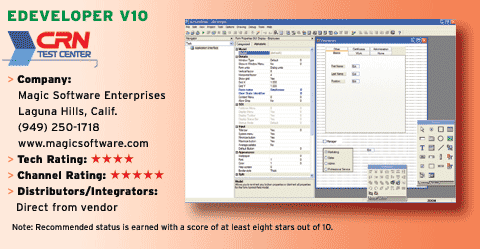Generating Web Services With Altova XML Suite 2006
When using Altova's MapForce, developers can generate code with little effort and make it reusable. Also, with MapForce, developers are able to accommodate multiple access points by reusing the same map to link the database to the application(s).
Altova's XML Suite provides a more sophisticated method than traditional programming methods by abstracting the code generation process using fields in a map. Reusable code is extremely difficult to develop from scratch because developers have to resort to parsing XML and non-XML files and link fields using code that is coupled to specific implementations. Anyone familiar with parsing text knows there are severe limits as to how far parsers can be abstracted from lexers. Writing reusable code this way creates unnecessary complications and requires highly skilled programmers.
A WSDL file is the first step to create the public methods and operations that developers need when exposing a Web service. The WSDL must be based on an XML Schema that matches a database Schema or some other non-relational Schema. Altova's XMLSpy can help developers build an XML schema from the ground up. XMLSpy provides various schema components such as elements, complex data types and model groups to build a Schema. When connecting to databases, XMLSpy automatically generates Schemas for developers.
When integrating fixed-width flat files from legacy applications, MapForce can help map file fields into XML files and generate a parser that transforms files into XML. The process is manual, but precise. Alternatively, developers can generate XML Schemas from flat files using DataDirect's Stylus Studio, which can speed up Schema development, in some cases. However, a manual inspection and correction is always necessary since Stylus' interpretation of XML files can be off. For more complex flat files, CRN Test Center engineers recommend using Monarch's VorteXML to generate valid XML files. VorteXML uses Monarch's unique dynamic parsing engine that can manipulate just about every complex legacy file ever created.
Once all of the building blocks of an XML document are created in a Schema, developers can use XMLSpy's graphical editor to create all of the bindings, operations and services in WSDL. XMLSpy provides a highly graphical process when associating data types from Schemas with WSDL operations.
Developers must also create all input and output elements. Input elements can receive parameters when customizing for various outputs. Input data types must match Schema data types and can be validated in MapForce. For each output message, developers can associate elements in a Schema to match a WSDL operation.
Once a WSDL is created, it is placed into MapForce, and developers can then create a mapping for each operation that is a defined WSDL file. To build rules to match various outputs or invoke Boolean comparisons rules, developers can drop icons to modify map links. MapForce can build highly complex map rules, without having developers resort to coding at any point. Once the mapping is created, MapForce can generate C#, Java, C++ and XSLT from the same mapping. When generating Java, developers can deploy the application using Ant. For C# output, MapForce can generate Visual Studio project files. To ensure that the Web service executes properly, developers can test SOAP messages using XMLSpy's SOAP debugger. The debugger is a proxy server that can be used to trap input and output messages from a Web service. Essentially, developers have to select which operations need to be trapped so output data can be verified when firing events. The input operations are created manually by modifying each request.
The company's support for partners is a three-tier channel program, which offers Member, Premier and Elite levels. Every new partner begins at the Member level and must reach a required revenue volume in order to be upgraded to the next. There are no time limits for reaching the next level, and as soon as a partner reaches its next revenue target, a level upgrade can be requested immediately. However, partner revenue is checked on a quarterly basis and its revenue requirements must be reached within four quarters to qualify for the Premier and the Elite Levels. If a partner does not reach its required revenue goal, the partner will fall to the next lower level after a period of 30 days to ensure that open quotes to customers can be processed as quoted. Purchase conditions and discounts vary between the levels. Additional marketing support such as sales training and incentive programs is available to high-growth and Elite-level partners.
For margins, Altova provides a base discount of 5 percent, 10 percent and 15 percent for Member, Premier and Elite partners, respectively. In addition, the purchase of certain products carries a bonus discount of 5 percent on top of the base discount. Products qualifying for bonus discounts vary.
Altova offers free product training delivered via online to all customers and partners. Altova also provides free technical support for all customers for 30 days after date of purchase. The company offers a Support and Maintenance Package (SMP), which provides free major software updates, all maintenance releases and priority technical support for the duration of the support period. It can be purchased for 25 percent of the product license price for a one-year period or 20 percent per year for a two-year period. There is also a secure online partner portal for Altova's registered partner community. The portal includes information on upcoming products, marketing collateral, images and other partner-support materials.
In brief, the company offers one of the best software channel programs seen by the Test Center. Flexibility and clearly identified goals and policies make Altova's channel program a winner.
